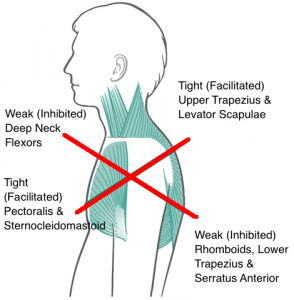ADVICE
Neck and Shoulder Pain 2
The forward head posture associated with Text Neck is often part of a bigger problem known as Upper Crossed Syndrome (UCS). Symptoms include headaches, pain in the neck, shoulders and upper back, a forward head posture, protracted shoulders and a rounded mid back.
You’ve probably guessed that UCS is most often caused by prolonged sitting at a desk, working in front of a screen. The accumulation of hours, days and months of sitting with the head and shoulders in a forward position causes the chest and posterior neck muscles to become short and overactive, eventually inhibiting the opposing muscles of the mid back and the deep flexor muscles of the neck, which become lengthened and weak, creating the “cross” you can see in the diagram.
The problem can be made worse, not better, by exercising incorrectly e.g. Cycling in a hunched forward position with shoulders up around ears, or concentrating on bench pressing heavy weights and not balancing it by strengthening the upper back. Over time the adaptation your body has made to its new posture can lead to other problems, such as reduced mobility in the shoulders and mid back, rotator cuff injury, aching or tingling down the arm, the development of trigger points and even disc herniation.
It sounds bad, but don’t be despondent! With an awareness of your poor posture, you can start to address the problems with a combination of release, stretch and strengthening exercises.
Here are some good ideas to counteract the effects described above, with an exercise plan easily done at home with some rubber bands and a foam roller.
One thing it doesn’t mention is self-myofascial release, which can provide relief from trigger points causing pain in the upper back or shoulders – all you need is a ball and a tennis ball.
- Stand against a wall with the tennis ball strategically placed between the wall and the point on your back that feels most tender.
- Lean back onto ball until you get a strong but satisfying pain sensation (I would use a maximum of 6/10 on the pain scale – too much pain will make you tense up against the pressure and will be ineffective.).
- Don’t move – just hold it there until the pain decreases to around a 4/10.
- Increase the pressure again and repeat the process.
- Move the tennis ball onto the next painful spot and repeat the process.
You can also perform this exercise by lying on the floor, but your body weight might cause too much pain, so use whichever way you feel is best for you.
Hopefully a combination of release, stretching and strengthening will resolve the problem, but if not, get some help!

